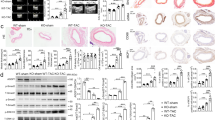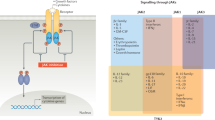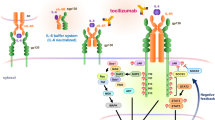Abstract
Conventional anti-inflammatory strategies induce multiple side effects, highlighting the need for novel targeted therapies. Here we show that knockdown of the basic-region leucine zipper protein, c-Jun, by a catalytic DNA molecule, Dz13, suppresses vascular permeability and transendothelial emigration of leukocytes in murine models of vascular permeability, inflammation, acute inflammation and rheumatoid arthritis. Treatment with Dz13 reduced vascular permeability due to cutaneous anaphylactic challenge or VEGF administration in mice. Dz13 also abrogated monocyte-endothelial cell adhesion in vitro and abolished leukocyte rolling, adhesion and extravasation in a rat model of inflammation. Dz13 suppressed neutrophil infiltration in the lungs of mice challenged with endotoxin, a model of acute inflammation. Finally, Dz13 reduced joint swelling, inflammatory cell infiltration and bone erosion in a mouse model of rheumatoid arthritis. Mechanistic studies showed that Dz13 blocks cytokine-inducible endothelial c-Jun, E-selectin, ICAM-1, VCAM-1 and VE-cadherin expression but has no effect on JAM-1, PECAM-1, p-JNK-1 or c-Fos. These findings implicate c-Jun as a useful target for anti-inflammatory therapies.
This is a preview of subscription content, access via your institution
Access options
Subscribe to this journal
Receive 12 print issues and online access
$209.00 per year
only $17.42 per issue
Buy this article
- Purchase on Springer Link
- Instant access to full article PDF
Prices may be subject to local taxes which are calculated during checkout




Similar content being viewed by others
Change history
10 June 2015
In the version of this article initially published, the first three bars in the histogram in Figure 1a should have read “No vehicle,” “No Dz” and “Dz13” instead of “No Dz,” “Dz13” and “Dz13scr.” The legend of Figure 1a should have included the sentences: “‘No vehicle’ represents the normoxia control without vehicle (transfection agent) or DNAzyme or siRNA. All other groups contain vehicle.” The H&E-stained images in Figure 1a should have read “Dz13 in hyperoxia-normoxia” and “Dz13scr in hyperoxia-normoxia” instead of “Normoxia” and “Hyperoxia-normoxia.” None of the conclusions is affected by the errors. The errors have been corrected in the HTML and PDF versions of the article.
References
Davies, N.M. Review article: non-steroidal anti-inflammatory drug-induced gastrointestinal permeability. Aliment. Pharmacol. Ther. 12, 303–320 (1998).
Botting, R. Antipyretic therapy. Front. Biosci. 9, 956–966 (2004).
Howard, P.A. & Delafontaine, P. Nonsteroidal anti-Inflammatory drugs and cardiovascular risk. J. Am. Coll. Cardiol. 43, 519–525 (2004).
Schuff, K.G. Issues in the diagnosis of Cushing's syndrome for the primary care physician. Prim. Care 30, 791–799 (2003).
Cirino, G., Fiorucci, S. & Sessa, W.C. Endothelial nitric oxide synthase: the Cinderella of inflammation? Trends Pharmacol. Sci. 24, 91–95 (2003).
Carmeliet, P. Angiogenesis in health and disease. Nat. Med. 9, 653–660 (2003).
Murohara, T. et al. Vascular endothelial growth factor/vascular permeability factor enhances vascular permeability via nitric oxide and prostacyclin. Circulation 97, 99–107 (1998).
Gamble, J.R. et al. Angiopoietin-1 is an antipermeability and anti-inflammatory agent in vitro and targets cell junctions. Circ. Res. 87, 603–607 (2000).
Ito, Y. et al. Inhibition of angiogenesis and vascular leakiness by angiopoietin-related protein 4. Cancer Res. 63, 6651–6657 (2003).
Chen, J. et al. Akt1 regulates pathological angiogenesis, vascular maturation and permeability in vivo . Nat. Med. 11, 1188–1196 (2005).
Santiago, F.S. et al. New DNA enzyme targeting Egr-1 mRNA inhibits vascular smooth muscle proliferation and regrowth factor injury. Nat. Med. 5, 1264–1269 (1999).
Lowe, H.C., Chesterman, C.N. & Khachigian, L.M. Catalytic antisense DNA molecules targeting Egr-1 inhibit neointima formation following permanent ligation of rat common cartoid arteries. Thromb. Haemost. 87, 134–140 (2002).
Khachigian, L.M., Fahmy, R.G., Zhang, G., Bobryshev, Y.V. & Kaniaros, A. c-Jun regulates vascular smooth muscle cell growth and neointima formation after arterial injury: inhibition by a novel DNAzyme targeting c-Jun. J. Biol. Chem. 277, 22985–22991 (2002).
Lowe, H.C. et al. Catalytic oligodeoxynucleotides define a key regulatory role for early growth response factor-1 in the porcine model of coronary in-stent restenosis. Circ. Res. 89, 670–677 (2001).
Zhang, G. et al. Effect of deoxyribozymes targeting c-Jun on solid tumor growth and angiogenesis in rodents. J. Natl. Cancer Inst. 96, 683–696 (2004).
Smith, L.E. et al. Oxygen-induced retinopathy in the mouse. Invest. Ophthalmol. Vis. Sci. 35, 101–111 (1994).
Engelhardt, B. & Wolburg, H. Transendothelial migration of leukocytes: through the front door or around the side of the house? Eur. J. Immunol. 34, 2955–2963 (2004).
Min, W. & Pober, J.S. TNF initiates E-selectin transcription in human endothelial cells through parallel TRAF-NF-kappa B and TRAF-RAC/CDC42-JNK-c-Jun/ATF2 pathways. J. Immunol. 159, 3508–3518 (1997).
Ahmad, M., Theofanidis, P. & Medford, R.M. Role of activating protein-1 in the regulation of the vascular cell adhesion molecule-1 gene expression by tumor necrosis factor-alpha. J. Biol. Chem. 273, 4616–4621 (1998).
Wang, N. et al. Adenovirus-mediated overexpression of c-Jun and c-Fos induces intercellular adhesion molecule-1 and monocyte chemoattractant protein-1 in human endothelial cells. Arterioscler. Thromb. Vasc. Biol. 19, 2078–2084 (1999).
Staines, N.A. & Wooley, P.H. Collagen arthritis–what can it teach us? Br. J. Rheumatol. 33, 798–807 (1994).
van Buul, J.D. & Hordijk, P.L. Signaling in leukocyte transendothelial migration. Arterioscler. Thromb. Vasc. Biol. 24, 824–833 (2004).
Santoro, S.W. & Joyce, G.F. A general purpose RNA-cleaving DNA enzyme. Proc. Natl. Acad. Sci. USA 94, 4262–4266 (1997).
Eyetech Study Group. Preclinical and phase 1A clinical evaluation of an anti-VEGF pegylated aptamer (EYE001) for the treatment of exudative age-related macular degeneration. Retina 22, 143–152 (2002).
Gragoudas, E.S., Adamis, A.P., Cunningham, E.T., Jr., Feinsod, M. & Guyer, D.R. Pegaptanib for neovascular age-related macular degeneration. N. Engl. J. Med. 351, 2805–2816 (2004).
Ferrara, N. Role of vascular endothelial growth factor in physiologic and pathologic angiogenesis: therapeutic implications. Semin. Oncol. 29, 10–14 (2002).
Parry, T.J. et al. Bioactivity of anti-angiogenic ribozymes targeting Flt-1 and KDR mRNA. Nucleic Acids Res. 27, 2569–2577 (1999).
Pavco, P.A. et al. Antitumor and antimetastatic activity of ribozymes targeting the messenger RNA of vascular endothelial growth factor receptors. Clin. Cancer Res. 6, 2094–2103 (2000).
Bitko, V., Musiyenko, A., Shulyayeva, O. & Barik, S. Inhibition of respiratory viruses by nasally administered siRNA. Nat. Med. 11, 50–55 (2004).
Fahmy, R.G. & Khachigian, L.M. Locked nucleic acid-modified DNA enzymes targeting early growth response-1 inhibit vascular smooth muscle cell growth. Nucleic Acids Res. 32, 2281–2285 (2004).
Breaker, R.R. Natural and engineered nucleic acids as tools to explore biology. Nature 432, 838–845 (2004).
Kagari, T., Doi, H. & Shimozato, T. The importance of IL-1 beta and TNF-alpha, and the noninvolvement of IL-6, in the development of monoclonal antibody-induced arthritis. J. Immunol. 169, 1459–1466 (2002).
Bolon, B., Morony, S., Cheng, Y., Hu, Y.L. & Feige, U. Osteoclast numbers in Lewis rats with adjuvant-induced arthritis: identification of preferred sites and parameters for rapid quantitative analysis. Vet. Pathol. 41, 30–36 (2004).
Acknowledgements
We thank Nick diGirolamo for his expertise in immunohistochemistry, and Ravinay Bhindi and Akiko Maekawa for their assistance with intra-articular and tail vein injections, respectively. This work was supported by grants from the NHMRC, NHF, Diabetes Australia, Cancer Council, Johnson & Johnson Research Pty Limited and the NSW Department of Health. L.M.K. is a Senior Principal Research Fellow of the NHMRC.
Author information
Authors and Affiliations
Contributions
All authors contributed intellectually and/or technically to this project. L.M.K. conceived, designed and supervised all aspects of the project.
Note: Supplementary information is available on the Nature Biotechnology website.
Corresponding author
Ethics declarations
Competing interests
The authors declare no competing financial interests.
Supplementary information
Supplementary Table 1
Dz13 inhibits c-Jun, E-selectin, VCAM-1, ICAM-1 and VE-cadherin expression in cytokine-treated mesenteric venules in rats. (PDF 83 kb)
Supplementary Table 2
Dz13 inhibits neutrophil and osteoclast accumulation, and neovascularization, in the synovial lining of the tibiotarsal joints in mice. (PDF 143 kb)
Rights and permissions
About this article
Cite this article
Fahmy, R., Waldman, A., Zhang, G. et al. Suppression of vascular permeability and inflammation by targeting of the transcription factor c-Jun . Nat Biotechnol 24, 856–863 (2006). https://doi.org/10.1038/nbt1225
Received:
Accepted:
Published:
Issue Date:
DOI: https://doi.org/10.1038/nbt1225
This article is cited by
-
Emerging therapeutic strategies for unmet need in neovascular age-related macular degeneration
Journal of Translational Medicine (2023)
-
Cooperative ETS transcription factors enforce adult endothelial cell fate and cardiovascular homeostasis
Nature Cardiovascular Research (2022)
-
Transcriptome clarifies mechanisms of lesion genesis versus progression in models of Ccm3 cerebral cavernous malformations
Acta Neuropathologica Communications (2019)
-
A systems biology network analysis of nutri(epi)genomic changes in endothelial cells exposed to epicatechin metabolites
Scientific Reports (2018)
-
Erratum: Corrigendum: Suppression of vascular permeability and inflammation by targeting of the transcription factor c-Jun
Nature Biotechnology (2015)



